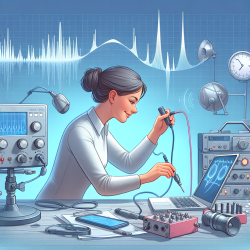Introduction
In the evolving landscape of speech analysis, the integration of smart devices and plug-and-play microphones has opened new avenues for remote voice assessment. The research article "Plug-and-Play Microphones for Recording Speech and Voice with Smart Devices" provides a comprehensive analysis of how consumer-grade microphones can be utilized effectively in both clinical and research settings. This blog post aims to distill the key findings of this research and offer practical insights for speech-language pathologists and other practitioners seeking to enhance their skills and improve outcomes for children through data-driven decisions.
Research Insights
The study conducted by Noffs et al. (2023) explored the efficacy of consumer-grade plug-and-play microphones compared to professional-grade equipment in capturing speech acoustics. The research highlights several critical points:
- Fundamental Frequency (f0) Robustness: Measurements of fundamental frequency (f0) and F2 slope were found to be robust across different recording equipment. This suggests that plug-and-play microphones can reliably capture these metrics, making them suitable for certain aspects of speech analysis.
- Limitations in Acoustic Metrics: Other acoustic metrics, such as mean pause length and pause length variability, showed significant variability when recorded with consumer-grade microphones. This variability indicates that these microphones should not be used interchangeably with professional-grade equipment for detailed speech analysis.
- Noise and Frequency Response: The study found that consumer-grade microphones favored high frequencies and recorded more noise compared to reference microphones. This finding underscores the importance of understanding the limitations of these devices in capturing accurate acoustic data.
Practical Applications for Practitioners
For practitioners in speech-language pathology, the insights from this research offer several practical applications:
- Selective Use of Plug-and-Play Microphones: While these microphones can be useful for capturing fundamental frequency and F2 slope, practitioners should be cautious when using them for more detailed acoustic analyses. Understanding the strengths and limitations of these devices can help practitioners make informed decisions about their use in clinical settings.
- Standardization of Equipment: The research emphasizes the need for equipment standardization within studies to ensure reliable comparisons. Practitioners should consider using consistent equipment across assessments to minimize variability in acoustic measurements.
- Continued Research and Development: The findings encourage further research into developing robust methods of signal analysis that can accommodate the limitations of consumer-grade microphones. Practitioners are encouraged to stay informed about advancements in this area to enhance their practice.
Conclusion
The integration of plug-and-play microphones with smart devices presents both opportunities and challenges for speech analysis. By understanding the capabilities and limitations of these devices, practitioners can make data-driven decisions that enhance their practice and improve outcomes for children. As the field continues to evolve, ongoing research and development will be crucial in optimizing the use of these technologies in clinical settings.
To read the original research paper, please follow this link: Plug-and-Play Microphones for Recording Speech and Voice with Smart Devices.










